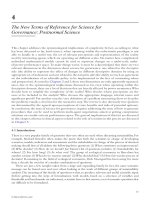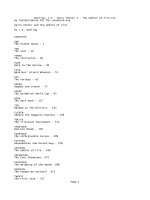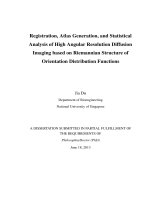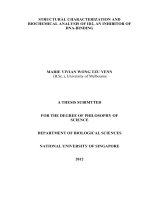Mathematical and computational analysis of intracelluar dynamics 4
Bạn đang xem bản rút gọn của tài liệu. Xem và tải ngay bản đầy đủ của tài liệu tại đây (44.38 KB, 7 trang )
68
Chapter 4
p53-MDM2 Oscillations
Intracellular protein levels of p53 and MDM2 have been shown to oscillate in
response to ionizing radiation. p53 and MDM2 are members of the p53-AKT
network studied previously in the preceding chapters. In particular, the p53-AKT
network embeds the p53-MDM2 negative feedback loop, which has been attributed to
cause the p53-MDM2 oscillations upon ionizing radiation induced DNA damage.
This chapter reviews the reported experimental observations of p53-MDM2
oscillations (Section 4.1), and the corresponding mathematical models that have been
developed in the last few years to simulate them (Section 4.2). The consequences of
p53-MDM2 oscillations on the predicted p53-AKT bistable switch are studied in the
following chapter.
4.1 Experimental evidence of p53 oscillations
Oscillations in p53 protein levels were initially reported in cell population studies
where damped oscillations were observed in response to DNA damage; see, for
examples, Figures 1 to 4 of Collister et al. (1998) and Figure 5 of Bar-Or et al.
(2000); Ohnishi et al., 1999. Damped oscillation means that the oscillation amplitude
decreases with subsequent pulses. Collister et al. (1998) observed that protein levels
of p53, p21 (a target gene of p53) and MDM2 showed damped oscillations in cell
69
populations of human wild-type and Bloom’s syndrome patients’ fibroblast, following
induction of DNA damage either by 20 J/m
2
of UV radiation or 2.5 Gy of ionizing
radiation (IR). Interestingly, the oscillation profiles between wild-type and cancer-
prone Bloom’s syndrome patients’ cell populations are markedly distinct when
induced under identical experimental conditions. On the other hand, Bar-Or et al.
(2000) reported damped oscillations of p53 and MDM2 protein levels in cell
populations of mouse fibroblasts and human breast cancer epithelial MCF-7 cells,
following 5Gy of IR.
The dynamics of the p53-MDM2 oscillator are clarified after single-cell
experiments on MCF7 cells revealed that these oscillations are sustained as long as
IR-induced (up to 10 Gy) DNA damage persisted, and could last for at least three
days: Figure 2D of Lahav et al. (2004), Figure 1B of Geva-Zatorsky et al. (2006);
Ramalingam et al., 2007. Reproducible observations include the following: periods
of oscillation are 4 to 7 hrs; peaks of MDM2 oscillations lag behind p53 peak for 1.5
to 2.5 hrs; periods of oscillations decrease with increasing IR intensity; and peaks of
p53 pulses display considerably more variations than their oscillation periods (Geva-
Zatorsky et al., 2006). Based on the positive correlation between the observed
numbers of p53 pulses with IR intensity (Lahav et al., 2004), the p53 response to
DNA damage has been referred to as a digital counter, with number of pulses
signaling which p53 target genes to induce. Despite that, the number of pulses among
cells showed variability when they are exposed to the same IR intensity (Geva-
Zatorsky et al., 2006) – in fact, one would obtain damped oscillations observed in cell
population studies by taking the average of the time-courses of p53 or MDM2 protein
levels from each individual cell.
70
Consistent with cell population and single-cell studies, p53-MDM2
oscillations are also observed in the intestine and spleen of living mice upon total-
body-irradiation with 5 Gy of IR; see Figure 5 of Hamstra et al. (2006). As expected,
the oscillations are damped, with periods ranging from 4.5 to 6 hrs.
Notably, p53-dependent transcription of PTEN upon irradiation-induced DNA
damage has been reported in MCF-7 (human breast cancer epithelial), human colon
carcinoma (HCT116), A172 (human glioblastoma), MEF (mouse embryonic
fibroblasts) and tissues of mouse small intestine, colon, kidney and liver (Feng et al.,
2007; Wang et al., 2005; Stambolic et al., 2001; Trotman and Pandolfi, 2003; Singh
et al., 2002] where p53 oscillations are also observed (Bar-Or et al., 2000; Lahav et
al., 2004; Geva-Zatorsky et al., 2006; Hamstra et al., 2006; Ohnishi et al., 1999;
Ramalingam et al., 2007).
4.2 Review of p53-MDM2 mathematical models
This section reviews the recent mathematical models developed to describe the
dynamics of the p53-MDM2 oscillator in a cell population (Bar-Or et al., 2000) or in
a single cell (Ciliberto et al., 2005; Ma et al., 2005; Wagner et al., 2005; Geva-
Zatorsky et al., 2006; Zhang et al., 2006; Bottani and Grammaticos, 2007). These
models focus on reproducing experimental observations as well as on the underlying
mechanisms. Common to them is the postulation that the mechanistic origin of the
abovementioned oscillations is the negative feedback loop between p53 and MDM2.
In the models, which are formulated by ODEs and rate expressions similar to the
71
kinetic models formulated in the preceding chapter, the p53-MDM2 oscillator is kick-
started by IR-induced DSBs (DNA double strand breaks), which lead to post-
translational modifications (PTMs) of p53 and MDM2 proteins (reviewed in Sections
2.2.2 and 2.3 of Chapter 2). These PTM events prolong the time required by MDM2
to degrade p53. Generally, these models generate p53-MDM2 oscillations using two
mechanisms, as discussed below.
The first group of models demonstrated the importance of a time-delay
mechanism to generate oscillations (Bar-Or et al., 2000; Ma et al., 2005; Wagner et
al., 2005; Geva-Zatorsky et al., 2006; Bottani and Grammaticos, 2007); these models
are also referred to as delay oscillators (Goldbeter, 2002; Monk, 2003). In the model
proposed by Bar-Or et al. (2000) to simulate damped p53-MDM2 oscillations that
match experimental observations in a cell population, a postulated intermediary part
list is used to produce a time-delay between p53 activation and p53-dependent
induction of MDM2. They demonstrated that only biologically meaningful damped
p53 and MDM2 oscillations are obtained for intermediate lengths of the time-delay.
On the other hand, models of Ma et al. (2005), Wagner et al. (2005), Geva-Zatorsky
et al. (2006: Model IV) and Bottani and Grammaticos (2007) considers the time-delay
due to the transcription and translation of MDM2 proteins; mRNA of MDM2 is
included in the models. These models generate sustained oscillations upon DNA
damage in individual cells. Notably, Geva-Zatorsky et al. (2006) show that the model
could generate sustained oscillations over a broad range of kinetic parameters that
match experimental observations.
72
In the second group of models (Ciliberto et al., 2005; Geva-Zatorsky et al.,
2006: Model V; Zhang et al., 2006), the p53-MDM2 negative feedback loop is
supplemented with a positive feedback loop to generate sustained oscillations
observed in single cells; these models are also referred to as relaxation oscillators
(Pomerening et al., 2003; Tyson et al., 2003). These models differed in the manner at
which the positive loop is connected to the oscillator. For instance, in the model of
Ciliberto et al. (2005), the positive loop is implemented as an abstract reaction step in
which p53 inhibits the translocation of cytoplasmic MDM2 to the nucleus and thereby
inhibiting MDM2-mediated degradation of p53. This abstract step is inspired by the
mutual antagonism loop between p53 and AKT. It will be shown in the next chapter
that the explicit modeling of the p53-AKT network not only generates steady-state
bifurcation diagrams that are distinct from those reported by them, but also provides
insights and predictions about the biological functions of such oscillations. In
addition, three different connectivity of the positive loop is considered by Zhang et al.
(2006) namely, MDM2-mediated activation of p53, a p53 self-activation loop and a
MDM2 self-activation loop. Interestingly, Geva-Zatorsky et al. (2006: Model VI)
show that a model that has two negative feedback loops on p53 could also generate
sustained oscillations over a wide range of kinetic parameters values.
Taken together, these models demonstrate that there are several biologically
plausible networks that could generate oscillations matching experimental
observations. Besides the mechanistic differences, these models can also be
differentiated by how the oscillations are born. For instance, oscillations are born
from a Hopf bifurcation in the models of Bar-Or et al. (2000), Ma et al. (2005),
Wagner et al. (2005) and Zhang et al. (2006: Models 1 and 3). In contrast,
73
oscillations are born from an unstable saddle node, or a homoclinic or saddle-node
invariant cycle (SNIC) bifurcation, by models of Ciliberto et al. (2005) and Zhang et
al. (2006: Model 2). In fact, dynamic differences between oscillations born from a
Hopf or homoclinic bifurcation can be used to identify biologically more plausible
models, as discussed in more detail in Section 5.8 of Chapter 5.
Alternatively, stochastic models of the p53-MDM2 feedback loop have been
developed to explain variability in p53 oscillations at the single-cell level (Proctor and
Gray, 2008). Proctor and Gray (2008) consider two separate mechanisms to kick start
the oscillator upon DNA damage in their stochastic models – ATM-mediated post-
translational modifications of p53 and MDM2, and ARF-mediated inhibition of
MDM2. The first mechanism has been utilized in several published p53-MDM2
models (Ma et al., 2005; Wagner et al., 2005). The model that use the second
mechanism however, could not match experimental observations that initial p53 pulse
is higher than subsequent pulses.
4.3 Summary
The various independent reports on the manifestation of sustained p53 and MDM2
oscillations after DNA damage on different cell types indicate that such a
phenomenon is reproducible in vitro and in vivo. Notably, recent efforts in
mathematical modeling of the p53-MDM2 network have illuminated the biophysical
mechanisms and conditions for the manifestation of such oscillations. Specifically, a
p53-MDM2 network that is either supplemented with a positive feedback loop or a
74
time-delay mechanism or both, is more plausible to generate sustained oscillations
over a wide range of kinetic parameters values.









